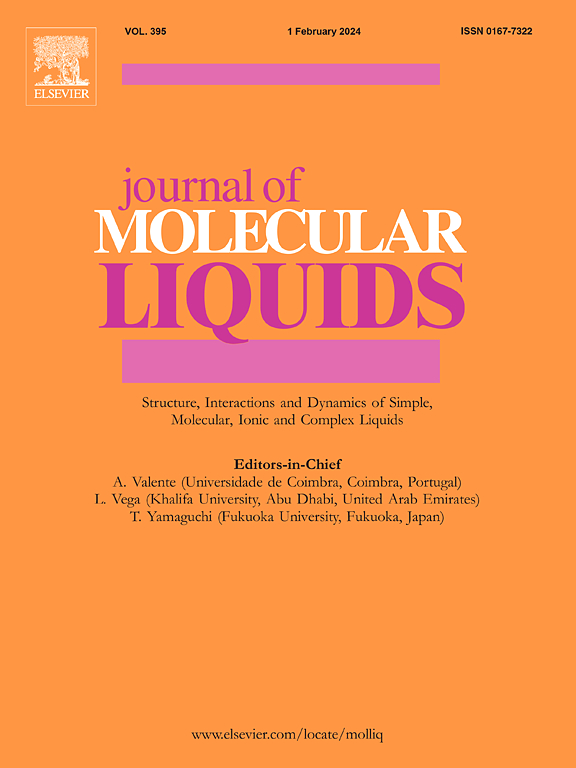Extending the Madrid-2019 force field to the perchlorate anion: Role of charge distribution and validation with experiments on Mars-relevant aqueous solutions
IF 5.3
2区 化学
Q2 CHEMISTRY, PHYSICAL
引用次数: 0
Abstract
The perchlorate anion (ClO) has garnered increasing interest in recent years due to its presence on Martian soil (and subsoil). In this study, we extend the Madrid-2019 force field (which uses a scaled charge of ±0.85e for monovalent ions and the TIP4P/2005 model for water) to the perchlorate anion. We propose two models with identical Lennard-Jones parameters but different charge distributions (i.e., the total charge of the anion is -0.85 in both models, but the partial charges assigned to the Cl and O atoms differ in each model). The experimental densities of several soluble perchlorate salts (i.e., LiClO4, NaClO4, KClO4, Mg(ClO4)2 and Ca(ClO4)2) are well described up to the solubility limit of each salt with both force fields. The viscosity of Mg(ClO4)2 and Ca(ClO4)2 solutions at 298.15 K and room pressure was also determined experimentally. The transport properties show differences due to the charge distribution; specifically, the model with a greater difference in partial charges between the ions is less viscous (thus exhibiting higher diffusion) and aligns more closely with experimental results. We also performed experimental measurements of density at ambient pressure as a function of temperature for supercooled Mg(ClO4)2 and Ca(ClO4)2 solutions and compared them against simulation results to locate the temperature at which the maximum in density occurs (TMD). The two models agree well with the experimental results although the exact location of the TMD is sensitive to the internal charge distribution within the perchlorate anion. Additionally, structural features of perchlorate solutions were calculated, finding negligible differences between the proposed models. Finally, we tested the possibility of combining the Madrid-2019 force field with the TIP4P/Ice model of water showing also excellent predictions of the experimental densities.
将马德里-2019力场扩展到高氯酸盐阴离子:电荷分布的作用及其在火星相关水溶液中的实验验证
高氯酸盐阴离子(ClO4−)近年来由于其在火星土壤(和底土)中的存在而引起了越来越多的兴趣。在这项研究中,我们将马德里-2019力场(对单价离子使用±0.85e的缩放电荷,对水使用TIP4P/2005模型)扩展到高氯酸盐阴离子。我们提出了两个具有相同Lennard-Jones参数但电荷分布不同的模型(即,阴离子的总电荷在两个模型中都是-0.85,但分配给Cl和O原子的部分电荷在每个模型中不同)。几种可溶性高氯酸盐(即LiClO4, NaClO4, KClO4, Mg(ClO4)2和Ca(ClO4)2)的实验密度在两种力场下都得到了很好的描述,直到每种盐的溶解度极限。实验还测定了Mg(ClO4)2和Ca(ClO4)2溶液在298.15 K和室温下的粘度。电荷分布不同,输运性质也不同;具体来说,离子之间部分电荷差异较大的模型粘性较小(因此表现出更高的扩散),并且与实验结果更接近。我们还对过冷的Mg(ClO4)2和Ca(ClO4)2溶液在环境压力下的密度作为温度的函数进行了实验测量,并将其与模拟结果进行了比较,以确定最大密度发生的温度(TMD)。虽然TMD的精确位置对高氯酸盐阴离子内部电荷分布很敏感,但这两个模型与实验结果吻合得很好。此外,计算了高氯酸盐溶液的结构特征,发现所提出的模型之间的差异可以忽略不计。最后,我们测试了将马德里-2019力场与水的TIP4P/Ice模型相结合的可能性,该模型也显示了对实验密度的出色预测。
本文章由计算机程序翻译,如有差异,请以英文原文为准。
求助全文
约1分钟内获得全文
求助全文
来源期刊

Journal of Molecular Liquids
化学-物理:原子、分子和化学物理
CiteScore
10.30
自引率
16.70%
发文量
2597
审稿时长
78 days
期刊介绍:
The journal includes papers in the following areas:
– Simple organic liquids and mixtures
– Ionic liquids
– Surfactant solutions (including micelles and vesicles) and liquid interfaces
– Colloidal solutions and nanoparticles
– Thermotropic and lyotropic liquid crystals
– Ferrofluids
– Water, aqueous solutions and other hydrogen-bonded liquids
– Lubricants, polymer solutions and melts
– Molten metals and salts
– Phase transitions and critical phenomena in liquids and confined fluids
– Self assembly in complex liquids.– Biomolecules in solution
The emphasis is on the molecular (or microscopic) understanding of particular liquids or liquid systems, especially concerning structure, dynamics and intermolecular forces. The experimental techniques used may include:
– Conventional spectroscopy (mid-IR and far-IR, Raman, NMR, etc.)
– Non-linear optics and time resolved spectroscopy (psec, fsec, asec, ISRS, etc.)
– Light scattering (Rayleigh, Brillouin, PCS, etc.)
– Dielectric relaxation
– X-ray and neutron scattering and diffraction.
Experimental studies, computer simulations (MD or MC) and analytical theory will be considered for publication; papers just reporting experimental results that do not contribute to the understanding of the fundamentals of molecular and ionic liquids will not be accepted. Only papers of a non-routine nature and advancing the field will be considered for publication.
 求助内容:
求助内容: 应助结果提醒方式:
应助结果提醒方式:


